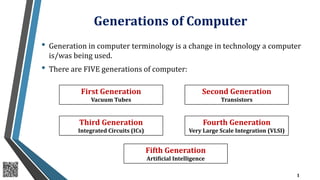
Lecture 03
- 1. Generations of Computer • Generation in computer terminology is a change in technology a computer is/was being used. • There are FIVE generations of computer: 1 First Generation Vacuum Tubes Second Generation Transistors Third Generation Integrated Circuits (ICs) Fourth Generation Very Large Scale Integration (VLSI) Fifth Generation Artificial Intelligence
- 2. First Generation of Computer • The period of first generation was 1946-1959. • The computers of first generation used vacuum tubes as the basic components for memory and circuitry for CPU (Central Processing Unit). • These tubes, like electric bulbs, produced a lots of heat and were prone to frequent fusing of the installations, therefore, were very expensive and could be afforded only by very large organizations. • In this generation mainly batch processing operating systems were used. • The computers in this generation used machine code as programming language. 2
- 3. First Generation of Computer 3
- 4. First Generation of Computer The main features of first generation are: • Vacuum tube technology • Unreliable • Supported machine language only • Very costly • Generated lots of heat • Slow input and output devices • Punched Cards and Paper Tape used for input • Huge size • Need of A.C. • Non-portable • Consumed lot of electricity 4
- 5. Input 5
- 6. Input 6
- 7. Input 7
- 8. Second Generation of Computer • The period of second generation was 1959-1965. • In this generation transistors were used that were cheaper, consumed less power, more compact in size, more reliable and faster than the first generation machines made of vacuum tubes. • In this generation, magnetic cores were used as primary memory and magnetic tape and magnetic disks as secondary storage devices. • In this generation assembly language and high-level programming languages like FORTRAN, COBOL were used. • The computers used batch processing and multiprogramming operating system. 8
- 9. Magnetic Cores • A magnetic core is a piece of magnetic material with a high ability used to guide magnetic fields in electrical, electromechanical and magnetic devices. 9
- 10. Second Generation of Computer 10
- 11. Second Generation of Computer The main features of second generation are: • Use of transistors • Reliable in comparison to first generation computers • Smaller size as compared to first generation computers • Generated less heat as compared to first generation computers • Consumed less electricity as compared to first generation computers • Faster than first generation computers • Still very costly • A.C. needed • Supported machine and assembly languages 11
- 12. Input 12
- 13. Third Generation of Computer • The period of third generation was 1965-1971. • The computers of third generation used integrated circuits (IC's) in place of transistors. • A single IC has many transistors, resistors and capacitors along with the associated circuitry. • The IC was invented by Jack Kilby. • This development made computers smaller in size, reliable and efficient. • In this generation remote processing, time-sharing, multi-programming operating system were used. • High-level languages (FORTRAN-II TO IV, COBOL, PASCAL PL/1, BASIC, ALGOL-68 etc.) were used during this generation. 13
- 14. Third Generation of Computer 14
- 15. Third Generation of Computer The main features of third generation are: • IC used • More reliable in comparison to previous two generations • Smaller size • Generated less heat • Faster • Lesser maintenance • Still costly • A.C needed • Consumed lesser electricity • Supported high-level language 15
- 17. Fourth Generation of Computer • The period of fourth generation was 1971-1980. • The computers of fourth generation used Very Large Scale Integrated (VLSI) circuits. • VLSI circuits having about 5000 transistors and other circuit elements and their associated circuits on a single chip made it possible to have microcomputers of fourth generation. • Fourth generation computers became more powerful, compact, reliable, and affordable. As a result, it gave rise to personal computer (PC) revolution. • In this generation time sharing, real time, networks, distributed operating system were used. • All the high-level languages like C, C++, DBASE etc., were used in this generation. 17
- 18. Fourth Generation of Computer 18
- 19. Fourth Generation of Computer The main features of fourth generation are: • VLSI technology used • Very cheap • Portable and reliable • Use of PC's • Very small size • No A.C. needed • Concept of internet was introduced • Great developments in the fields of networks • Computers became easily available 19
- 21. Fifth Generation of Computer • The period of fifth generation is 1980-till date. • In the fifth generation, the VLSI technology became ULSI (Ultra Large Scale Integration) technology, resulting in the production of microprocessor chips having ten million electronic components. • This generation is based on parallel processing hardware and AI (Artificial Intelligence) software. • AI is an emerging branch in computer science, which interprets means and method of making computers think like human beings. • All the high-level languages like C and C++, Java, .Net etc., are used in this generation. 21
- 22. Fifth Generation of Computer Artificial Intelligence (AI) includes: • Robotics • Neural Networks • Development of expert systems to make decisions in real life situations. • Natural language understanding and generation. 22
- 23. Fifth Generation of Computer 23
- 24. Fifth Generation of Computer The main features of fifth generation are: • ULSI technology • Development of true artificial intelligence • Development of Natural language processing • Advancement in Parallel Processing • Advancement in Superconductor technology • More user friendly interfaces with multimedia features • Availability of very powerful and compact computers at cheaper rates 24
